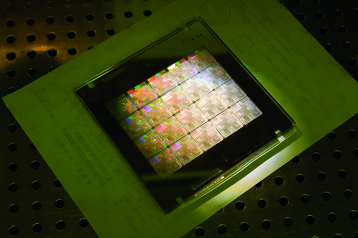Nvidia's cuLitho software library is being used by TSMC and Synopsys for production chip development.
GPU designer Nvidia announced the computational lithography library this time last year, saying that contract chip manufacturers TSMC and ASML were testing it out, alongside chip design tools company Synopsys.
"A chip is made up of trillions of shapes, or rectangles, each one is so tiny that you can fit 1,000s of them across the width of a single human hair," Vivek Singh, Nvidia's VP of advanced technology, told DCD during a pre-briefing ahead of GTC.
"And because these things are so tiny, you need a $300 million camera to transfer that chip design onto silicon - but even that fancy camera doesn't have the required resolution. So you need some additional tricks.
"Essentially, you have to solve an inverse math problem to trick light into printing the correct shapes. That calculation has quietly become the largest single computation workload in the entire semiconductor industry. It's called computational lithography. And this is especially true in the [extreme ultraviolet] EUV era."
Singh said that Nvidia and its partners had "demonstrated that these accelerations can be used for a broad set of technologies, for example, curvilinear inverse lithography which will be required to extend the frontiers of semiconductor scaling, as TSMC would tell you."
When it first announced cuLitho, Nvidia claimed that the GPU-powered library delivers a performance leap of up to 40× beyond current lithography - with 500 Nvidia DGX H100 systems (now 350) able to achieve the work of 40,000 CPU systems.
It expects to extend that lead further. "This has been the year of generative AI, and we are no exception," Singh said.
"We applied generative AI to this very interesting and complicated problem. We're amazed to find that generative AI gives you an additional 2× boost in performance on top of the accelerated computing I described. So all these things will really help the entire semiconductor industry to build chips that are more powerful and more energy efficient."
Nvidia founder and CEO Jensen Huang added: “Computational lithography is a cornerstone of chip manufacturing. Our work on cuLitho, in partnership with TSMC and Synopsys, applies accelerated computing and generative AI to open new frontiers for semiconductor scaling.”
Dr. C.C. Wei, CEO of TSMC, said: “Our work with Nvidia to integrate GPU-accelerated computing in the TSMC workflow has resulted in great leaps in performance, dramatic throughput improvement, shortened cycle time and reduced power requirements. We are moving Nvidia cuLitho into production at TSMC, leveraging this computational lithography technology to drive a critical component of semiconductor scaling.”
Separately, Nvidia has developed ChipNeMo, a large language model (LLM) to help its own employees design chips.




